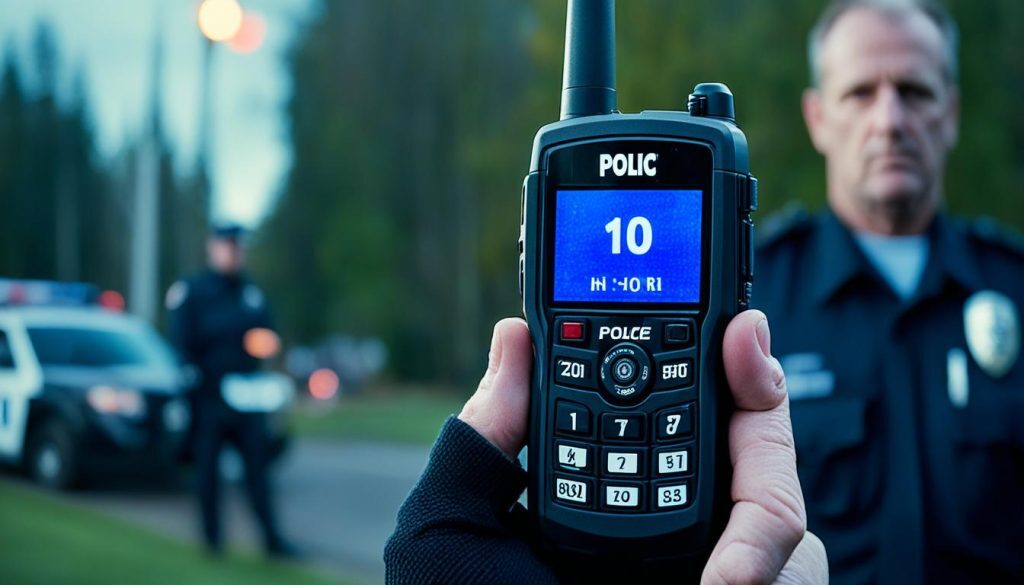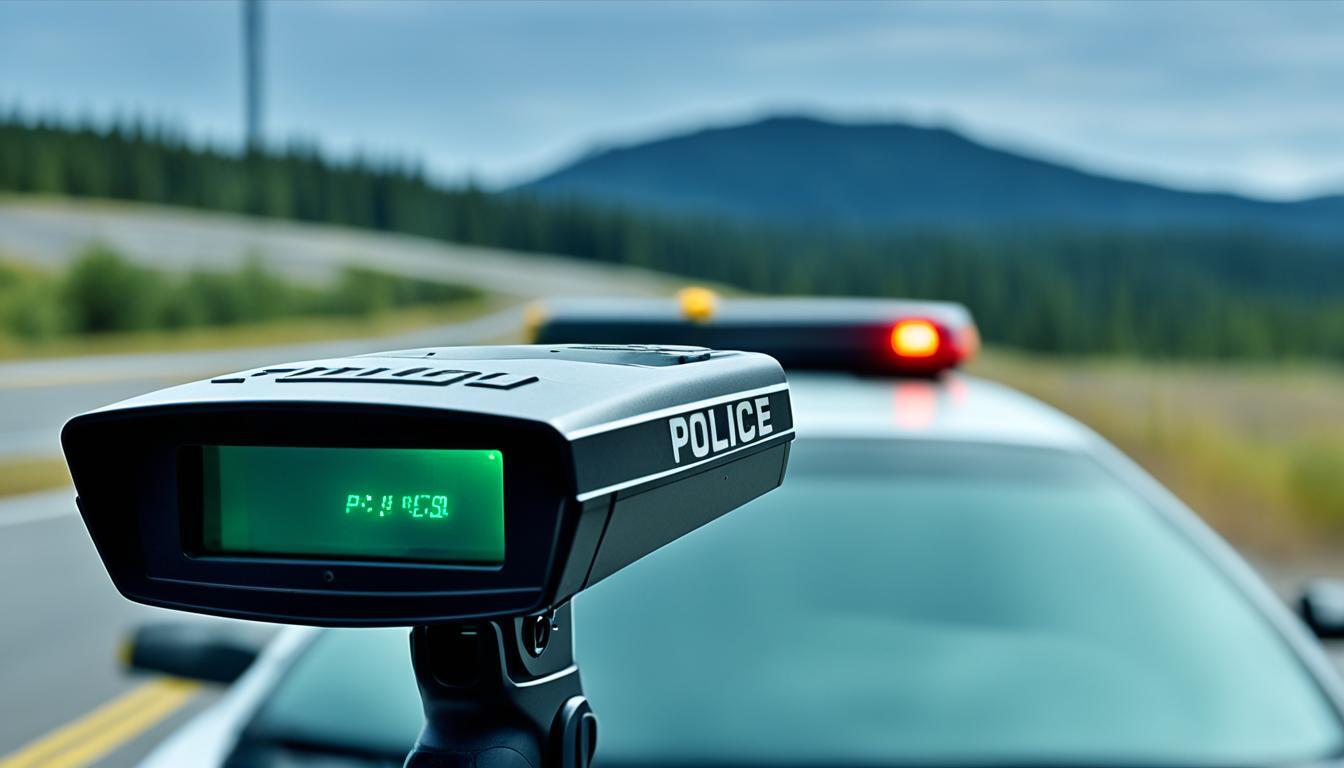Understanding Police Code 10-4: What It Means
Did you know that police codes, also known as 10 codes, have been used for decades to streamline communication in law enforcement? One of the most widely recognized and commonly used codes is 10-4. But what does 10-4 actually mean? Let’s dive into the significance and history of this code and its role in law enforcement communication.
Key Takeaways:
- Police code 10-4 signifies acknowledgment or understanding in law enforcement communication.
- It was developed by the Association of Public-Safety Communications Officials-International (APCO) in the 1930s.
- The code ensures clear transmission by allowing radio transmitters to reach full power.
- Although there is no standardization in recent years, 10-4 is still widely used by law enforcement personnel.
- Police codes, including 10-4, play a crucial role in efficient and secure communication among officers.
The History of Police Code 10-4
The development of police code 10-4 can be traced back to the 1930s when the APCO Ten Signals were created to streamline communication on police radio channels. These codes were introduced to overcome the limitations of radio communication at the time. One of the notable codes that emerged during this period was 10-4.
Charles “Charlie” Hopper, the communications director for the Illinois State Police, is credited with inventing the code 10-4. Its primary purpose was to allow radio transmitters sufficient time to reach full power, ensuring clear transmission of the message. The code was specifically designed to signify acknowledgment or understanding in law enforcement communication.
Over time, the code 10-4 gained widespread recognition and adoption. The Association of Public-Safety Communications Officials-International (APCO) played a vital role in standardizing and incorporating the code into various projects. Despite advancements in communication technology and the recommendation to use everyday language, the code 10-4 has remained a prominent and widely understood phrase in law enforcement communication.

Variations of Police Code 10-4 Across Jurisdictions
| Jurisdiction | Code 10-4 Meaning |
|---|---|
| APCO Standard | Acknowledgment or understood |
| New York Police Department (NYPD) | Understood or copy that |
| Los Angeles Police Department (LAPD) | Message received or understood |
While the code 10-4 is widely recognized and understood in law enforcement, variations and adaptations exist across different jurisdictions and departments. For example, the New York Police Department (NYPD) has its own set of codes, including variations of 10-4. It’s crucial for law enforcement personnel to familiarize themselves with the specific codes used in their jurisdiction to ensure effective communication.
The Significance of 10-4 in Law Enforcement
The code 10-4 holds significant importance in law enforcement communication. It serves as a confirmation or acknowledgment of a received message. When an officer receives a message and replies with 10-4, they are indicating that they have understood and acknowledged the information or instruction given. This code is crucial for effective and efficient communication between officers and dispatchers, as it ensures that messages are received and understood. The code 10-4 is used in various situations, including confirming the receipt of instructions, verifying that assistance is on the way, or acknowledging a status update.

Examples:
| Scenario | Example |
|---|---|
| Confirming Instructions | An officer receives instructions to proceed to a specific location and replies with 10-4 to confirm that they have understood and will comply with the instructions. |
| Verifying Assistance | If an officer requests backup or assistance, they may receive a response of 10-4 from the dispatcher, indicating that help is on the way. |
| Acknowledging Status Update | If an officer provides an update on their current status, such as arriving at a scene or completing a task, they may receive a reply of 10-4 to acknowledge the update. |
Variations and Adaptations of 10-4
While the code 10-4 is widely recognized and understood in law enforcement, there are variations and adaptations of this code across different jurisdictions and departments. In some cases, the code 10-4 may have different meanings or be replaced by a different code entirely. It is important for law enforcement personnel to familiarize themselves with the specific codes used in their jurisdiction to ensure effective communication.
For example, the New York Police Department has its own set of codes that differ from the APCO system. These codes, known as “10 codes,” are used to convey information quickly and efficiently over the radio. While the code 10-4 remains a widely recognized and used phrase in law enforcement communication, some departments may have adopted modified versions or entirely different codes that serve the same purpose.
To illustrate the variations that can exist, below is a comparison between the APCO code 10-4 and the New York Police Department’s code for the same message:
| Code | Meaning |
|---|---|
| 10-4 (APCO) | Affirmative/Acknowledgment/Understood |
| Signal 4 (NYPD) | Acknowledged |
As shown in the table above, while both codes convey the same general meaning of acknowledgment, there is a variation in the specific code used. This highlights the importance of understanding the codes utilized within a specific jurisdiction.
Law enforcement agencies implement variations and adaptations of codes to meet their unique communication needs. These modifications can be influenced by factors such as local context, department protocols, or historical precedence. It is crucial for law enforcement officers to be well-versed in the specific codes used in their area to facilitate clear and effective communication.
In the next section, I will delve into the importance of police codes in communication and how they contribute to streamlined information transmission and enhanced operational efficiency.
The Importance of Police Codes in Communication
Police codes, including 10-4, play a crucial role in law enforcement communication. These codes provide a standardized and efficient way of transmitting information over radio channels.
By using codes instead of full sentences or explanations, officers can convey messages quickly and concisely, saving valuable time in emergency situations. This is particularly important when every second counts and clear communication is essential for effective response and coordination.
Codes also add an additional layer of security by ensuring that sensitive information is not easily understood by unauthorized listeners. In situations where confidentiality is paramount, using codes allows law enforcement personnel to communicate sensitive information without compromising operational security.
Despite advancements in technology and the recommendation to use plain language, police codes continue to be an integral part of law enforcement communication. They have become ingrained in standard operating procedures and are deeply rooted in the culture and tradition of law enforcement agencies.
Enhancing Communication Efficiency
Using police codes enables officers to relay important information quickly and efficiently. This is especially crucial in high-stress situations where officers need to share critical updates within seconds or request immediate assistance.
The brevity of codes allows for rapid transmission and reception, ensuring that crucial instructions or details are received and understood without delay. This efficiency is further enhanced by the familiarity that officers have with the codes, making it easier to interpret messages accurately and respond accordingly.
Preserving Radio Bandwidth
The use of police codes also helps to conserve radio bandwidth, which is a limited resource. When officers communicate using full sentences or explanations, it can quickly consume valuable airtime and limit the ability of other units to communicate. Codes remedy this issue by condensing complex messages into concise signals, allowing for a more efficient use of radio frequency spectrum.
This not only facilitates smoother and faster communication between officers but also ensures that radio channels remain available for other important transmissions. In situations where multiple units are operating simultaneously, such as during large-scale emergencies or major events, the use of codes becomes even more crucial in preventing radio congestion and maintaining operational effectiveness.
Standardization and Interoperability
Police codes provide a common language for law enforcement agencies across different jurisdictions and regions. Standardization of codes allows officers from different departments to communicate seamlessly, even when operating jointly during emergencies or special events.
When officers understand and use the same set of codes, it promotes interoperability and facilitates cooperative efforts. This unified approach enhances coordination, information exchange, and overall effectiveness during joint operations.
| Benefits of Police Codes in Communication |
|---|
| Efficient and rapid transmission of information |
| Increased operational security |
| Conservation of radio bandwidth |
| Promotion of interoperability |
In conclusion, the importance of police codes, like 10-4, in law enforcement communication cannot be overstated. They ensure efficient and secure communication, optimize the use of radio resources, and facilitate coordination among officers from different jurisdictions. While there has been a shift towards using plain language, the use of codes remains integral to effective law enforcement communication.
The Future of Police Codes
In recent years, there has been a growing movement within law enforcement to shift towards using plain language in communication. This shift aims to enhance clarity and avoid confusion, as the use of codes can sometimes lead to misinterpretation. It is interesting to note that even the U.S. federal government recommended the discontinuation of police codes in 2006, favoring everyday language instead.
However, despite this recommendation, police codes, including the widely known code 10-4, continue to hold significant importance and remain widely understood within the law enforcement community. While there may be variations and adaptations of codes across different jurisdictions, their use is expected to remain an integral part of law enforcement communication in the foreseeable future.
Although the move towards plain language is understandable, police codes offer several advantages that contribute to their continued relevance. First and foremost, codes allow for quick and efficient transmission of information, saving valuable time in emergency situations. By using concise codes instead of lengthy sentences, officers can communicate essential details swiftly and effectively. Additionally, police codes add an extra layer of security by preventing unauthorized listeners from easily comprehending sensitive information.




















Post Comment Cancel reply